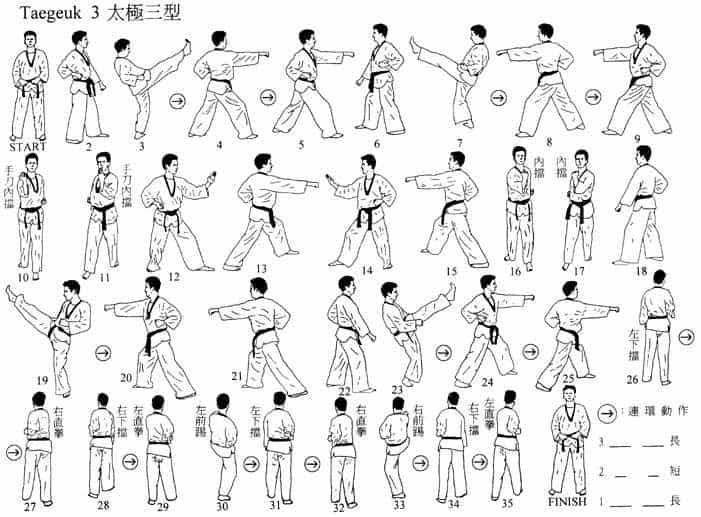Green Belt Form – Taegeuk Sam Jang
The Tae Kwon Do Poomsae 3 or more formally known as the Taegeuk Sam Jang form represents the symbol of Ri meaning fire (hot & bright) encouraging the student to develop their training and to promote a sense of justice.
Ri is feminine, and represents South. The actions of Ri should be performed with variety and passion, like the flickering of a fire.
Like the fire, this form is filled with changing bursts of power connected with a continuous flow of motion. It teaches combinations, specifically those hand combinations that are used in free fighting, such as a Front Kick followed by a Double Punch, a Front Kick followed by a Low Block and a Reverse Middle Punch, and a Single Knife-Hand Block followed by a Reverse Middle Punch.
After practicing these combinations in this form, they can be applied in free sparring.
Terms Used with the Form:
- Joon Bi Seogi– Ready Stance (i.e. “at ease”)
- KiHap – Shout
- Poomsae – Form
- Momtong Jireugi – Middle Punch
- Arae Makki – Low Block
- Ap Seogi – Walking Stance
- Sonnal Makk i– Knife Hand Block
- Montong Maki – Mid Section Block
- Ap Chagi – Front Kick
- Dwitkubi Seogi – Back Stance
Video Of Green Belt Form – Taegeuk Sam Jang
I have found that this Poomsae (as well as the others) can be more easily followed by combining the video and written form
Green Belt Form – Taegeuk Sam Jang – Step by Step:
Step 1:
From Joon Bi Seogi, turn to your left with your left foot forward and execute a left low block.
Step 2:
Perform a front kick with your right foot and as soon as it lands, deliver a right middle punch followed by a left middle punch!
Step 3:
Turn 180 degrees on your left foot, landing your right foot ahead and getting your right arm in a low block.
Step 4:
Do a left front kick and continue with a left middle punch followed by a right middle punch!
Step 5:
Turn 90 degrees to your right, now facing the front, and perform a sideway reversed-knife hand or ridge hand with your right hand; to do this you have to let your palms open and slightly tuck the upper part of your thumb into your palm, make sure your arm is straight as you swing your arm to the front!
Step 6:
Step forward once with your right foot while delivering a sideway ridge hand with your left arm.
Step 7:
Bring your left foot to align with your right, but have it point to the right side of the room as you simultaneously execute Hansonnal Montong Maki with your left arm. Hansonnal Montong Maki is what you call a middle block with an open palm facing your opponent, instead of a closed fist.
Step 8:
Half-step forward with your left foot while executing a right middle punch.
Step 9:
Turn 180 degrees on your left foot so that you are facing your right side with your right leg in front of your left. Now, execute a Hansonnal Montong Maki with your right arm.
Step 10:
Half-step forward with your right foot while executing a left middle punch.
Step 11:
Face the front by turning 90 degrees to the left on your right foot and deliver a right middle block.
Step 12:
Step forward once with your right foot while delivering a left middle block.
Step 13:
Turn 270 degrees to your left and execute a left low block.
Step 14:
Perform a front kick with your right leg and follow it up with two middle punches starting with the right fist, closely followed by the left.
Step 15:
Turn 180 degrees to your right side and deliver a right low block
Step 16:
Perform a front kick with your left leg and follow it up with two middle punches starting with the left fist, closely followed by the right.
Step 17:
Turn 90 degrees to your left and execute a left low block, followed by a right middle punch in one fluid motion!
Step 18:
Step forward with your right leg once and execute a right low block, followed by a left middle punch in one fluid motion!
Step 19:
Perform a front kick with your left foot, followed by a left low block and immediately followed by a right middle punch!
Step 20:
Perform a front kick with your right leg, followed by a right low block and immediately follow it up with a left middle punch. Afterwards, return to Joon Bi Seogi
Remember the Following:
- The form should begin and end at exactly the same spot. This indicates the quality of the students stances and technique.
- Correct posture and body position must be maintained at all times.
- Muscles of the body should be either tensed or relaxed at the proper, critical moments in the form.
- The exercise should be performed in a rhythmic movement with an absence of stiffness.
- Movement should be accelerated or decelerated according to the specifications of that pattern.
- Exhale on exertion of each technique in order to maximize power.
- Each pattern should be perfected before moving to the next.
- Students should know the purpose of each movement.
Tips
Always keep your posture straight and strong to maintain balance and stability in your movements!In performing this form as well as all the others, you should think not of executing techniques in a vacuum, but rather of responding to attacks from a number of opponents surrounding you.
You should always turn your head first, look at your imaginary opponent, then perform the required block or attack.
Always wait for the “Baro!” or end signal of your master before getting into Joon Bi Seogi after every form; this shows that you are taught to be disciplined during Tae Kwon Do sessions.


